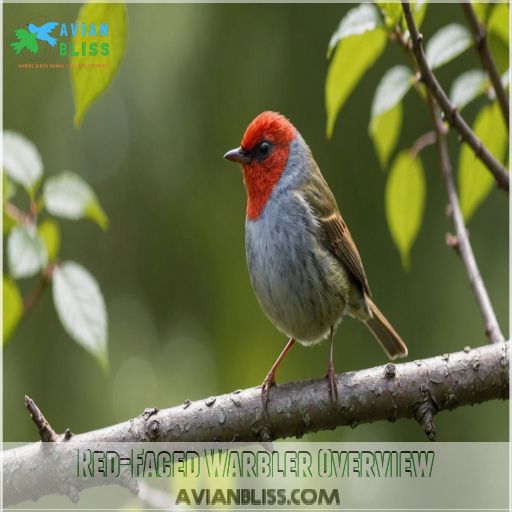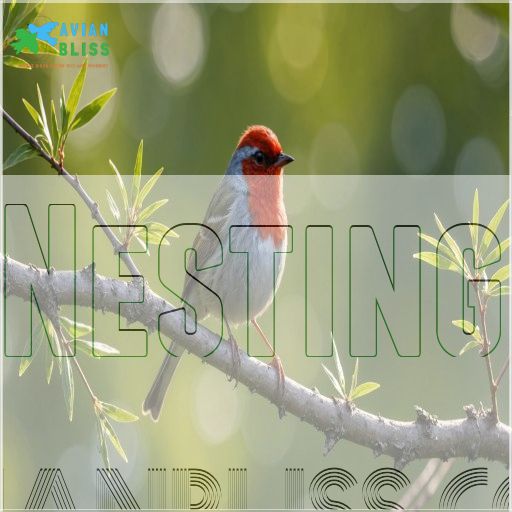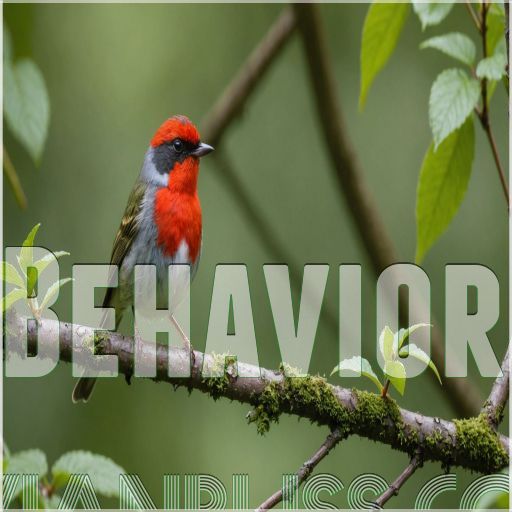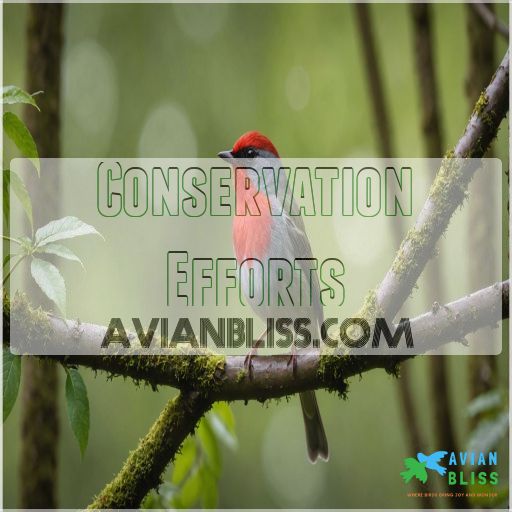This site is supported by our readers. We may earn a commission, at no cost to you, if you purchase through links.
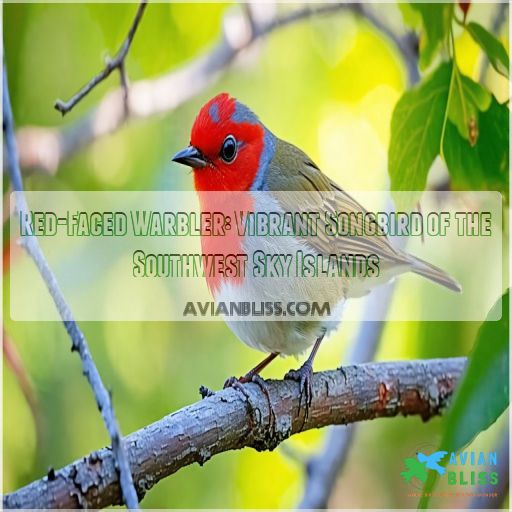 Spotting a red-faced warbler is like finding a ruby in the forest. With its bright red face, black head, and gray and white body, this little bird thrives in the high-elevation coniferous forests of the southwestern U.S. and Mexico.
Spotting a red-faced warbler is like finding a ruby in the forest. With its bright red face, black head, and gray and white body, this little bird thrives in the high-elevation coniferous forests of the southwestern U.S. and Mexico.
It’s not just a looker but a fighter, defending its territory with spirited song duels. It feasts mainly on insects, employing nifty hover-gleaning tactics.
Despite its beauty, habitat threats loom large, but conservation efforts are in play. Curious about its odd nesting habits or how they navigate their world? There’s more to this tale than meets the eye.
Table Of Contents
- Key Takeaways
- Red-Faced Warbler Overview
- Physical Characteristics
- Red Facial Plumage
- Gray and White Upperparts
- Black Head and Bright Red Cheeks
- Small Bills and Body Size
- Sky Islands in the Southwestern US
- Northwestern Mexico
- Breeding Grounds in Arizona and New Mexico
- Wintering Grounds in Mexico and Northern Central America
- Dense Foliage and Coniferous Trees
- Caterpillars as Primary Food Source
- Hover-Gleaning and Pursuing Insects
- Omnivorous Diet With Fruits and Seeds
- Breeding Behavior
- Nesting
- Behavior
- Conservation Efforts
- Where to See Red-Faced Warblers
- Frequently Asked Questions (FAQs)
- Where is the best place to see a red-faced warbler?
- What does a red warbler look like?
- What do Red-faced Warblers eat during migration?
- Do Red-faced Warblers form mixed-species flocks?
- How does climate change affect their migration?
- Are Red-faced Warblers calls used in mating rituals?
- How high do Red-faced Warblers typically forage?
- Conclusion
Key Takeaways
- Spot the red-faced warbler’s vibrant red cheeks and black cap in the sky islands of the southwestern US, similar to the Black-throated Green Warbler’s breeding habitats
.S. and Mexico – it’s like nature’s tiny superhero with a brilliant mask.
- Watch these feisty songsters as they defend their territory with spirited duels and courtship dances, showcasing their evolutionary advantage in their mating displays.
- Support conservation efforts to protect the red-faced warbler’s coniferous forest habitats, ensuring these colorful migrants continue to grace our landscapes for generations.
- Grab your binoculars and head to Arizona or New Mexico for an unforgettable birdwatching experience, as you witness the red-faced warbler’s agile foraging and cheerful songs in its natural habitat.
Red-Faced Warbler Overview
You’ll spot the Red-faced Warbler flitting through the sky islands of the southwestern U.S. and northwestern Mexico, showing off its fiery red cheeks and melodic song.
These birds are small but mighty, thriving in diverse habitats and enthralling bird watchers with their vibrant looks and lively behavior.
Physical Characteristics and Appearance
When you spot a red-faced warbler, you’re likely to be enchanted by its striking red facial plumage and the contrasting black head—which looks like it’s sporting a jaunty cap, similar to that of the Red-Headed Woodpeckers.
Its gray upperparts and white underside provide the perfect backdrop. Its vibrant red coloration is reminiscent of other red-headed birds like the Red-Headed Finches.
Add a small bill and compact body size, and you’ve got a charming neotropical migrant worth sharing stories about.
Habitat and Range
Imagine stumbling upon the stunning Red-faced Warbler in the sky island ecology of Arizona and New Mexico.
This bird thrives in high-elevation, coniferous forests, highlighting the elevation impact on its habitat and range.
Conservation challenges include habitat fragmentation, with efforts guided by the Migratory Bird Treaty Act to help their cheerful songs grace our landscapes for years.
Behavior and Breeding
The Red-faced Warbler’s mating rituals are a sight to behold.
Pairs engage in social monogamy, but extra-pair activity is common.
Males establish territories and attract mates with their cheerful songs.
Both parents build the nest and care for the young, though the female does most of the incubating.
Habitat destruction remains a threat to this species.
Diet and Feeding Habits
After raising young, Red-Faced Warblers focus on food—like you trying to pick the perfect snack.
Their diet consists mainly of insects:
- Forage among coniferous and deciduous trees.
- Snap up scale insects and caterpillars, meeting nutritional needs.
- Adapt to a seasonal diet to adjust to prey.
They relate to yellow and Lucy’s warblers in patterns and preferences. (Source)
Conservation Status
Grasping the Red-Faced Warbler’s plight, you see its conservation status classified as Least Concern, despite threats like habitat loss and decreasing population trends. It’s a delicate balance.
The Migratory Bird Joint Venture and partners like the American Bird Conservancy focus on conservation strategies with the U.S. Fish and Wildlife Service in Central America. Every effort counts.
| Factor | Status | Efforts |
|---|---|---|
| Population | Large, decreasing | Monitoring and protection |
| Habitat Loss | Ongoing | Habitat restoration |
| Conservation | Essential | Migratory Bird Joint Venture |
Physical Characteristics
When you spot a Red-faced Warbler, you’ll notice its striking red cheeks and small, compact size—it’s like nature’s tiny superhero with a brilliant mask.
This colorful bird, with its gray and white upperparts and distinctive black head, flits through trees, adding a fascinating splash of color to the forests of the southwestern U.S., among other birds with black heads
.S. and Mexico, its natural habitat featuring a brilliant display of color reminiscent of a brilliant mask.
Red Facial Plumage
Imagine spotting a red-faced warbler in the sky islands of the Madrean Archipelago. Its striking red facial plumage isn’t just for show.
It has multiple roles:
- Plumage variation: Enhances mating displays.
- Sexual selection: Attracts mates.
- Coloration function: Engages avian vision.
- Evolutionary advantage: Signal of fitness.
Marvel at such vivid beauty!
Gray and White Upperparts
Spot that striking red face? Well, let’s talk upperparts! The Red-Faced Warbler‘s gray and white feathers offer a masterclass in camouflage. Marvel at their color variation and feather patterns that contrast beautifully against their vibrant face.
Explore North America, where they mingle with the southwestern willow flycatcher, elf owl, and whiskered screech-owl.
| Feature | Description | Interaction |
|---|---|---|
| Gray Feathers | Sleek and subtle | Camouflage |
| White Underparts | Crisp and clean | Upperparts contrast |
| Seasonal Changes | Subtle shifts | Color variation |
| Other Birds | Elf Owl | Coexistence |
Black Head and Bright Red Cheeks
Imagine the warbler’s striking contrast: its sleek black head perfectly accentuates those red cheeks, much like the distinctive head markings of black and white birds
.
This vivid coloration isn’t just fashionable; it’s an evolutionary advantage in mating displays, creating a flair that rivals any blackpoll warbler’s show.
As you explore New Mexico’s madrean archipelago, look for this colorful wonder—a true beacon in a thriving, bird-friendly life.
Small Bills and Body Size
You mightn’t expect it, but the Red-Faced Warbler packs a lot into its petite frame. With a small, slender bill, this little bird deftly plucks insects from the foliage, relying on its nimble flight to catch its prey. Its diminutive size belies its big personality, as it boldly defends its territory and serenades potential mates with its cheerful song.
- The Red-Faced Warbler’s bill is perfectly suited for its diet of insects, caterpillars, and small fruits.
- Its compact body allows it to nimbly maneuver through dense forest canopies in search of food.
- Despite its small stature, the Red-Faced Warbler is a fierce defender of its breeding grounds.
- The warbler’s diminutive size is in contrast to its vibrant red facial plumage, which helps it attract mates.
Sky Islands in the Southwestern US
The Southwestern US Sky Islands are nature’s patchwork quilt, combining diverse ecosystems due to mountaintop isolation and varying climates.
As you explore, you’ll notice how climate change impacts these unique ecosystems, posing conservation challenges.
Rich in biodiversity, these islands are like hidden treasure troves, with each “island” showcasing life’s resilience —a delightful challenge for nature lovers.
Northwestern Mexico
Amid Northwestern Mexico’s enchanting Sky Islands, Red-faced Warblers thrive in a mosaic of forests—from tall conifers to scrubby deserts.
Their vibrant faces are an unexpected treat against the backdrop of gray and white upperparts.
Keep an eye on population trends, as habitat shifts pose conservation challenges.
Even the warbler’s brilliantly red cheeks can’t solve that puzzle.
Breeding Grounds in Arizona and New Mexico
Spotting Red-faced Warblers in Arizona and New Mexico offers a thrill.
Imagine these vibrant birds thriving in high-elevation Hawaiian forests like those above 4,100 feet between 6,500 and 9,200 feet
.
They favor nesting habitats rich with pine, oak, and fir trees.
Population trends show sensitivity to logging, highlighting conservation threats.
Climate change impacts their breeding season, but witnessing their resilience is pure joy.
Wintering Grounds in Mexico and Northern Central America
Imagine traversing the majestic landscapes of Mexico and Northern Central America where Red-faced Warblers charm onlookers with their vivid plumes.
You’ll find them delighting in higher altitudes, mingling with pine, oak, and fir trees.
Their wintering grounds aren’t just havens but essential for survival amidst looming conservation threats and climate change impacts, providing an irreplaceable refuge.
Dense Foliage and Coniferous Trees
Even in the thick of dense coniferous forests, red-faced warblers find their niche. You’ll spot them among towering trees, perfectly adapted to take advantage of the insect abundance and nesting sites.
These habitats are:
- Full of evergreen beauty.
- Key for the species’ survival amidst habitat loss.
- Managed through sustainable forest management practices to maintain nature’s balance.
Caterpillars as Primary Food Source
The Red-faced Warbler adores caterpillars—wiggling delights that make up a big chunk of its diet.
With caterpillar abundance in its habitat, you’ll see a happy warbler employing strategic foraging methods.
These little green critters are essential, influencing the warbler’s diet variation and ecological impact, while guiding conservation implications for maintaining their preferred lush environments.
Hover-Gleaning and Pursuing Insects
Ah, the red-faced warbler’s hover-gleaning prowess! These agile acrobats flit and flutter, snatching insects mid-air with lightning speed.
They’ll even raid spiderwebs, robbing the arachnids of their hard-earned prey.
Watch as they deftly maneuver through the forest canopy, their bright red faces a striking contrast against the green foliage, showcasing their agile acrobats .
Omnivorous Diet With Fruits and Seeds
You’ll find Red-Faced Warblers enjoy a varied diet, tapping into seasonal fruit availability with splashy enthusiasm. Their seed preferences are more selective, creating fun dietary shifts. Watch their foraging strategies unfold as they juggle food competition. Imagine a tiny acrobat, balancing nutrition as deftly as tightrope walkers at a circus of taste.
- Fruit choices shift seasonally.
- Preferred seeds vary widely.
- Foraging mimics strategic plays.
Breeding Behavior
In terms of breeding behavior, you’ll find Red-faced Warblers interesting as they form monogamous pairs but often engage in extra-pair flirtations.
You might enjoy watching the males as they fiercely establish territories and the females diligently construct cup-shaped nests.
Both parents feed their young with dedication.
Monogamous Pairs With Extra-Pair Copulation
While red-faced warblers typically form monogamous pairs, they’re not immune to a little feathered flirtation. These birds engage in extra-pair copulation, adding spice to their love lives and genetic diversity to their offspring. It’s like nature’s version of "what happens in the forest, stays in the forest."
Let’s take a closer look at the juicy details of their mating strategies:
| Behavior | Evolutionary Benefit | Social Impact |
|---|---|---|
| Monogamy | Stable parental care | Strong pair bonds |
| Extra-pair mating | Increased genetic diversity | Potential conflict |
| Nocturnal forays | Cryptic mate selection | Reduced detection |
| Female choice | Best gene acquisition | Empowered females |
| Male mate guarding | Paternity assurance | Heightened vigilance |
This avian soap opera isn’t just for thrills—it’s a carefully balanced act of evolutionary chess .
Males Establishing Territory and Attracting Mates
Every spring, male Red-faced Warblers transform into feathered Casanovas, vying for prime real estate in the high-elevation forests.
You’ll witness a dazzling display of avian courtship as these vibrant songsters pull out all the stops to win their lady loves.
Their breeding success hinges on:
- Belting out complex melodies that’d make Mozart jealous
- Strutting their stuff in elaborate courtship dances
- Defending their patch of pine-oak paradise with gusto
- Showcasing their excellent bug-catching skills
It’s like a miniature soap opera in the treetops!
Females Building Cup-Shaped Nests
Once the male’s serenade has sealed the deal, it’s time for the female to get her hands dirty—or should we say, her beak full of twigs!
She’s the master architect, crafting a cozy cup-shaped nest on the ground. It’s like she’s building a tiny woodland fortress, using bark, leaves, and pine needles, with a soft lining of grass and animal hair.
Talk about a DIY queen!
Both Parents Feeding the Young
After the female Red-faced Warbler builds her cozy cup-shaped nest, it’s all hands on deck for chick-rearing! Both parents roll up their sleeves to feed their hungry brood.
- Dad’s on guard duty, keeping predators at bay while mom incubates
- Fledglings stick around, getting parental TLC for weeks after leaving the nest
- Parents tag-team feeding, bringing a smorgasbord of insects to their chicks
Talk about a family affair!
Nesting
You’ll find Red-faced Warblers’ nests tucked away on the ground, often hidden beneath a plant stem, log, or rock.
These clever birds build cup-shaped nests using a variety of materials, creating cozy homes for their eggs and chicks during the breeding season.
Nest Placement on the Ground or in Trees
While most warblers build their nests high in trees, Red-faced Warblers break the mold.
You’ll find their nests tucked away on the ground, often at the base of a tree or on a slope. It’s like they’re playing hide-and-seek with predators.
This clever ground-nesting strategy offers unique protection, with overhanging rocks or vegetation serving as nature’s umbrella. Talk about thinking outside the box – or should we say, outside the branches?
Nest Description and Materials
Red-faced warblers are master architects when it comes to nest building. They craft their cozy abodes from a variety of materials, including juniper bark, twigs, and leaves. These feathered interior designers don’t stop there – they’ll often add grass, oak leaves, and even spider cocoons for that extra touch of comfort.
Like some black birds with red chests, these warblers showcase a remarkable versatility in foraging techniques, using a variety of materials to construct their nests.
The finished product? A cup-shaped masterpiece about 3.2 inches across and 2 inches tall, held together with nature’s glue: spider silk.
Nesting Facts and Breeding Season
The delicate dance of nesting begins as you venture into Red-faced Warbler territory.
You’ll find these feathered architects selecting cozy ground spots, often nestled at the base of a tree. Their cup-shaped nests, woven with bark and pine needles, cradle 4-5 eggs.
As spring unfolds, both parents pitch in, nurturing their chicks through a 12-day incubation period.
It’s a family affair, with dad lending a helping wing in chick-rearing duties, making it a true family affair.
Behavior
You’ll find red-faced warblers to be intriguing little performers, from their melodious songs to their flashy courtship displays.
These social birds fiercely defend their territories while also engaging in complex mating behaviors.
They have the surprising habit of seeking out extra-pair mates, which is part of their complex mating behaviors.
Social Behavior and Interactions
You’ll find red-faced warblers to be quite the social butterflies of the avian world. These charming birds have a knack for balancing solo time with group interactions.
- Forming alliances with other species for nest defense
- Engaging in lively territory disputes with neighboring warblers
- Participating in mixed-species flocks during non-breeding seasons
They also have some interesting behaviors when it comes to defending their territory and their personal lives:
- Showing off their "knights of the prairie" moves when protecting their turf
- Juggling parental duties with a dash of extra-pair mating excitement
Courtship Displays and Mating
Love is in the air when Red-faced Warblers start their courtship dance! These feathered Romeos pull out all the stops, hopping from treetop to treetop in a dazzling display (Source).
You’ll spot males offering berries or insects as love tokens, passing them back and forth with their potential mates.
It’s like a tiny avian tango, complete with snacks! This ritual strengthens their bond and sets the stage for nest building and raising chicks together.
Territorial Defense and Agonistic Behavior
Once the courtship dance ends, red-faced warblers shift gears to protect their turf. These feisty feathered friends don’t mess around when it comes to defending their slice of paradise, often employing clever foraging techniques like gleaning and sallying to outmaneuver rivals.
You’ll witness a fascinating display of avian assertiveness:
- Wing-quivering standoffs with intruders
- Dramatic aerial chases to expel rivals
- Fierce song duels echoing through the trees
- Impressive crest-raising to appear larger
It’s like a tiny, melodious battleground where only the boldest birds win!
Conservation Efforts
You’ll play a key role in safeguarding the Red-faced Warbler’s future by supporting conservation efforts.
These initiatives focus on preserving stopover sites, restoring breeding grounds, and implementing bird-friendly policies.
This support will make sure these colorful songbirds continue to grace our sky islands for generations to come.
Protecting Stopover and Wintering Areas
Red-faced warblers don’t just need a comfy home; they’re road warriors facing serious pit stop problems.
Climate change and habitat fragmentation are turning their migration routes into obstacle courses .
But don’t worry, you’re not powerless! By supporting conservation partnerships, you’re helping create a network of protected stopover sites.
Think of it as building bird-friendly motels along their flyways. Your actions can make their journey smoother and help guarantee these feathered frequent flyers keep coming back.
Habitat Conservation and Restoration
Countless sky islands face threats, but you can help restore Red-faced Warbler habitats.
Logging impacts and fire mismanagement have taken their toll, but there’s hope.
Join citizen science projects to monitor populations and support restoration efforts. You’ll feel a sense of belonging as you work alongside others to create mosaic forests.
It’s like piecing together a giant, living puzzle – challenging, but oh-so-rewarding when you see those red cheeks flitting through the trees you’ve helped save, feeling a sense of belonging.
Bird-Friendly Policies and Practices
You’re ready to make a difference? Bird-friendly policies help preserve warbler habitats!
Implement these practices in your area:
- Embrace sustainable forestry to maintain and restore forests.
- Support laws that reduce pesticide use, keeping birds safe and chirpy.
- Encourage local communities to create backyard bird feeders, promoting bird-friendly gardens.
It’s easy, impactful, and nature will thank you!
ABC’s BirdScapes Approach
While bird-friendly policies set the stage, ABC’s BirdScapes approach puts the spotlight on habitat restoration.
Envision vast landscapes where humans and migratory birds like the Red-faced Warbler coexist in harmony.
BirdScapes cleverly connect conservation strategies across regions, ensuring migratory birds have welcoming homes. It’s like rolling out a green carpet for our feathered friends! .
Where to See Red-Faced Warblers
Spotting a Red-Faced Warbler can feel like finding a pint-sized treasure in the rugged mountains of Arizona and New Mexico.
You’ll need keen eyes and perhaps a bit of luck, as these colorful birds flit among the high-altitude forests.
Often near streams or in dense foliage.
Best Places for Spotting Red-Faced Warblers
Conserving their habitat brings us to the joy of actually seeing Red-faced Warblers.
For an amazing birding experience, head to Arizona’s sky island locations like Miller Canyon and Mount Lemmon.
These spots, alive with dense foliage, are prime during the breeding season.
Keep your binoculars ready and enjoy the vibrant spectacle that unfolds in these lush hideaways, providing an amazing birding experience .
Migration Patterns and Timing
Picture yourself observing Red-faced Warblers journeying from mountainous breeding sites in Arizona and New Mexico to winter grounds in Mexico.
They don’t just fly south; they embrace specific migration routes and stopover locations designed for their habitat use .
Timing variations can impact their survival, highlighting conservation implications that make preserving these paths essential.
Tips for Observing Red-Faced Warblers in the Wild
Exploring Red-Faced Warblers’ migration patterns leads us to prime birdwatching spots in Arizona and New Mexico’s dense foliage, as seen in Virginia’s small bird habitats, particularly in places like Shenandoah National Park Small Birds in Virginia
.
Head out at dawn when they sing their charming tunes. Listen for high-pitched calls and look for flitting red faces amongst conifer trees.
Bring patience and keen eyes—nature’s concert awaits, making you feel like part of their enchanting world, as you experience the Red-Faced Warblers in their natural habitat.
Frequently Asked Questions (FAQs)
Where is the best place to see a red-faced warbler?
Ever wondered where to spot a red-faced warbler?
Head to the mature coniferous forests of Arizona or New Mexico, above 6,500 feet.
They’re a treat to find among the trees with their vibrant red faces.
What does a red warbler look like?
A red warbler, or Red-faced Warbler, sports striking fire-engine red on its face and throat, with a contrasting black cap and grayish wings.
This vividly colored bird often forages high in dense coniferous trees.
What do Red-faced Warblers eat during migration?
During migration, Red-faced Warblers feast on a smorgasbord of insects found among dense foliage.
You’ll catch them flitting around branches, devouring caterpillars, flies, and leafhoppers, ensuring they fuel up for the journey ahead .
Do Red-faced Warblers form mixed-species flocks?
Yes, Red-faced Warblers sometimes join mixed-species flocks, especially in the non-breeding season.
Flocking with other birds like chickadees or kinglets can make finding food easier and provide extra safety from predators.
Who wouldn’t want that?
How does climate change affect their migration?
Imagine a world reshaping beneath the wings of Red-faced Warblers.
Climate change shifts their migratory path, causing potential mismatches with food supply and new ecological pressures.
They may struggle finding suitable habitats along their journey (Source) due to these ecological pressures.
Are Red-faced Warblers calls used in mating rituals?
Red-faced Warblers use vocalizations in their mating rituals, with males singing to attract females and establish territory.
Their cheerful songs echo through forest canopies, helping them stand out and potentially catching the attention of a mate.
How high do Red-faced Warblers typically forage?
You’ll find Red-faced Warblers mostly foraging in coniferous trees, often at mid-levels or outer foliage.
Males tend to forage higher in trees than females during the summer, picking off insects with agile moves.
Conclusion
Imagine the thrill of uncovering a red-faced warbler, nature’s flamboyant masterpiece, flitting through high-elevation pine forests.
These striking birds demand attention with their vibrant plumage but also captivate with their spirited song duels and unique nesting habits.
The red-faced warbler is a treasure worth conserving, and your adventure in spotting one will contribute to understanding and protecting their picturesque habitats.
So grab your binoculars and explore their stomping grounds for an unforgettable birdwatching experience.

